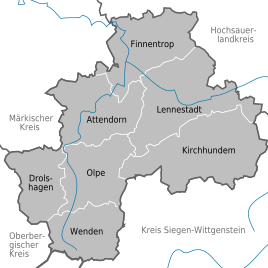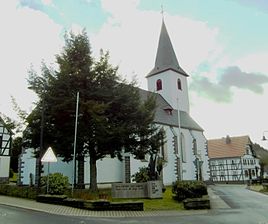Serkenrode
|
Serkenrode
Finnentrop municipality
Coordinates: 51 ° 12 ′ 48 ″ N , 8 ° 4 ′ 47 ″ E
|
||
|---|---|---|
| Height : | 350 m above sea level NHN | |
| Residents : | 714 (December 31, 2016) | |
| Incorporation : | 1st July 1969 | |
| Postal code : | 57413 | |
| Area code : | 02724 | |
|
Location of Serkenrode in the district of Olpe |
||
|
St. Johannes-Baptist in the town center
|
||
Serkenrode is located in the Sauerland-Rothaargebirge nature park and is a typical Sauerland village and part of the community of Finnentrop with around 710 inhabitants. From 1810 to 1969 the administration of the Serkenrode office was located here .
The old Sauerland architectural style of half-timbered houses has remained in many buildings to this day. The village is 360 m above sea level in the valley, with the mountains surrounding the place reaching up to almost 600 m above sea level. Serkenrode is also located on the SauerlandRadring in the Frettertal. The Fretterbach , which forms an essential part of the water supply for the towns of Finnentrop , Bamenohl and Weringhausen further downstream , crosses the village.
history
The oldest objects that document a stay of people in the area of the Fretter - the Frettertal - come from the Neolithic Age (4500/400–1800 BC). In 1905 a polished, pierced ax made of crystalline rock and a stone ball 10 cm in diameter were found near the Fretter spring . In 1955, while working in the field in Serkenrode, a Neolithic rectangular ax made of greywacke was found. Until around 500 AD, the mountainous region between the middle Lenne and the Wenne, in the middle of which Serkenrode is today, seems to have been a deserted forest wilderness. However, the first smaller settlements must have existed by 800 AD at the latest. Between 900 and 1000 AD the population in the Fretter area increased more rapidly. Proof of this is the archaeologically proven construction of a larger church in Schönholthausen .
The first written mention of the place Serkenrode seems to be in a register around 1150. There a place called "Sirencrothe" is mentioned - linguistically there is no concern that this is the early form of the name Serkenrode. The first undisputed mention can be found in the property register of Count Wilhelm von Arnsberg from 1313, in which it is said that "Luscede Serkenrode" is enfeoffed with a hoof in Serkenrode.
In addition to the first mention in 1313, various other spellings of the place are listed in a more recent study of the place names in the Olpe district. Examples are: 1338: Noderingo de Serkenrode, 1416: Selkenrode, 1543 Serckenroide (in an appraisal register ) and a. Based on the basic word "-rode" as an earlier designation for settlements that arose after the clearing of forests, and its probable connection to the personal name "Sariko / Seriko", the place name is interpreted as "clearing of Sariko or Seriko" .
Early clues about the size of Serkenrode come from an appraisal register (used to collect taxes) from 1543. According to this, there were 15 taxpayers in “Serkenroide” at that time (excluding 4 people who were classified as pauper or poor). The number of those liable for the treasury is likely to have roughly matched the existing families or houses.
The church of St. Johannes Baptist , which characterizes the townscape , probably dates back to a court chapel from the 16th century when it was founded. In 1901 this was expanded to its current size. A tower was added to the church in the 1950s. The current appearance of the church dates from 1958/59.
For a period of more than 150 years (1810–1969) the official administration had its seat in Serkenrode. In the years 1810–1843 it was still a mayor's district. Until 1912 , the administration of the Serkenrode office was housed in the house of the Kayser officials (Franz Kayser was the first “ mayor of the Serkenrode peasantry, Eslohe office , in the Duchy of Westphalia”) . The administration only moved with the construction of what is still known today as the official building in 1909. With the entry into force of the law on the reorganization of the district of Olpe , the Serkenrode office ceased to exist after 126 years of existence with effect from July 1, 1969. At the same time the new municipality of Finnentrop was formed. She was the legal successor to the Serkenrode office.
See also
literature
- Serkenrode and the parish Schliprüthen in the Sauerland region of Cologne. Edited by the Catholic parishes of St. Johannes Bapt., Serkenrode, and St. Georg, Schliprüthen. Paderborn undated (1991)
Web links
- www.serkenrode.de
- Serkenrode in the Westphalia Culture Atlas
Individual evidence
- ↑ Population statistics of the municipality of Finnentrop (as of December 31, 2016). (PDF) Municipality of Finnentrop, accessed on May 16, 2017 .
- ↑ cf. in detail Flöer, Michael: The place names of the district of Olpe, Westphalian Place Name Book (WOB), Bielefeld, Verlag für Regionalgeschichte 2014, pp. 222,223
- ↑ Archived copy ( memento of the original from October 3, 2011 in the Internet Archive ) Info: The archive link was inserted automatically and has not yet been checked. Please check the original and archive link according to the instructions and then remove this notice. Page 91
- ↑ Serkenrode and the parish Schliprüthen


